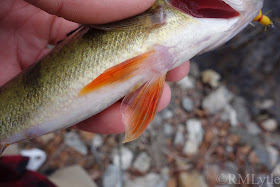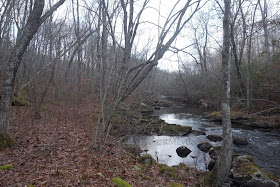Two of the more prolific CT winter coastal fisheries exist in the same waters an rely on the same bait. Resident striped bass, the fishery I am most bored of, and anadromous white perch, the fishery I have figured out least, keep lines tight in the dead of winter in the states tidal rivers. I say I'm most bored of the resident striped bass because I've done it, I've done it, I've done it, I've done it... through the ice, in rivers and backwaters, with spey rod, with a five weight, with 7x tippet, with three fly rigs getting tripled up, I've done it to death. Now I go out of desperation. As much as I love small stream wild trout, this time of year that's about the only remotely consistent thing right around home and it can get old I thrive on variety and this time of year lacks it. And, more like a broken calendar than a broken clock, this probably isn't the first time you're seeing me write this sort of thing at this very time of year. Noah and I went out of desperation recently. We knew we could count on stripers, we thought we could probably find some perch too. Big white perch have become our nemesis. For years we've hunted for them without success. Many of the traditionally great white perch fisheries seem to be almost dead. Hamburg Cove being the prime example. In recent years the late winter-early spring white perch run in Hamburg has all but petered out. I've not caught a single white perch there, among the yellows that abound in every marina and cove of the Connecticut River at that time of year. Those observations have been mirrored by those that fish there more than I. Precious few white perch get caught there anymore. To add insult to injury, not only can we not seem to find big white perch where others no longer are, Noah and I can't seem to catch big white perch where people still
are catching them. Part of this, I'm sure, is out fixation on artificials. If we had used bait all these years we'd probably have caught at least a few. Specifically, if we had used grass shrimp.
Grass shrimp, or
Palaemonetes, remain abundant in tidal creeks through the winter months in the Northeast. The species that seems to be most prevalent in Long Island Sound is
Palaemonetes pugio. Other baitfish have mostly left: bay anchovies, silversides, and menhaden are no longer available in any significant abundance to predator fish along the coast of CT in the winter months. Atlantic herring, various killifish and sticklebacks, and small white perch do provide a forage base for any larger species that may stick around, but on the whole grass shrimp are what's for dinner. Of course, the resident stripers, if they are feeding, will typically eat just about anything presented to them appropriately. It was a dark, rainy day, after a heavy rain that poured a lot on tannin stained water into the system. Dark day, dark water, dark fly. It seemed to make a difference.

Noah started with a Whip-it Fish then changed to a lighter jig and fluke to get a slower fall rate, And though he caught on both the lighter presentation was more productive. A slow fall rate is not to be underestimated, especially when the fish are moving slow and suspended. In fact this is often a huge advantage a fly angler has over an angler using any other method.
We did try for perch a bit, though our attempts were unfocused and unsuccessful. We'd never tried to acquire grass shrimp for bait before though, and that was very easy with a dip net. I think if we'd had more daylight there'd have been an end to the long losing streak. I'm confident we'll figure it out this winter. I'm sure I've said that before already....
Before I leave you, I'd like to ask a favor. The winter resident striper fishery in CT is very sensitive and heavily exploited. Poaching is rampant and mishandling and poor fighting claim higher numbers of released stripers under their stressed state in the very cold water. Please, if you take part in this fishery, be responsible. Don't go as light as you can with your tackle as tempting as it may be, and yes I have done it in the past and it was very selfish of me. Release the fish quickly, don't take them out of the water if the air temperature is below freezing. Please, please report poaching, whether you think a conservation officer will get there in time or not. Frankly, I wouldn't be heartbroken if January through March were a completely closed season, not just to keeping stripers but to all fishing for them. It's a bad look, the CT holdover fishery. Without some self-regulation, it's going to continue to be that way.
Until next time.
Fish for the love of fish.
Fish for the love of places fish live.
Fish for you.
Thank you to my Patrons; Erin, David, John, Elizabeth, Brandon, Christopher, and Shawn for supporting this blog on Patreon.


















































